- Home
- Knitting Instructions
- Cables Without A Cable Needle
Knitting Cables Without a Cable Needle - Oh My!
Knitting cables without a cable needle is easier than you might think.
In fact you might even think knitting cables is easier now that you don't have to worry about the cable needle.
I used to avoid knitting cables altogether until I found this one cable knitting technique.
Now I totally understand! This cable knitting technique is not for everyone but you just might like it too.
I think taking away that extra knitting tool, the cable needle, made it feel more doable somehow.
And now I want to show you how to knit cables without cable needle too just in case it helps you too.
It makes knitting cable stitches way more fun too
So let's get started knitting a cable stitch
So as a reminder, knitting cable stitches is a matter of rearranging the order that you knit stitches.
You're going to cross one set of stitches in front or behind another set of stitches. And the cable needle is used to hold a set of stitches
The problem is, sometimes the stitches fall off the cable needle or the cable needle can be so darn awkward to use. It was for me.
But as soon as I learned how to knit a cable without a cable needle it all became a lot easier somehow.
And the thought of dropping a couple of stitches off your needle sounds scary right?
But wait, the whole process is really quick and barely noticeable. And you'll be holding them so it works out just fine. Really.
The nice thing is it can also save a lot of time and frustration.
How to knit cables without a cable needle
Remember: All you're doing is rearranging the order of the stitches on the needle. That's all it is.
I'm going to show you the 4 stitch right cross cable stitch.
Step 1. These are the 4 stitches I am working with.
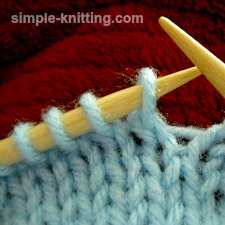
Step 2. With your right needle push it through the front of the second 2 stitches on the left needle. Those 2 sts will remain on the right needle. The blue arrows show the 4 stitches I'm working with.
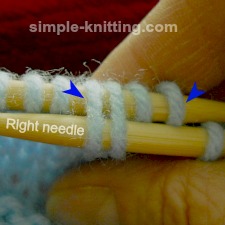
Step 3. With your left needle slide first 2 stitches off the left needle. Gently pinch those 2 live stitches to keep them in place. As I mentioned above the second 2 stitches remain on the right needle
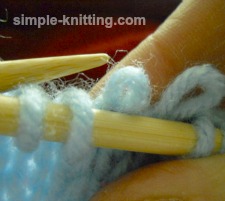
It's okay stay calm. They're not going anywhere.
Step 4. Now with your left needle quickly slide it through the 2 live stitches.
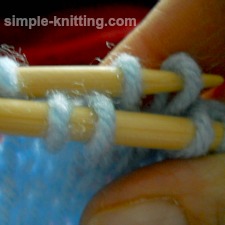
Step 5. Gently pull the left needle away from the right needle a bit.
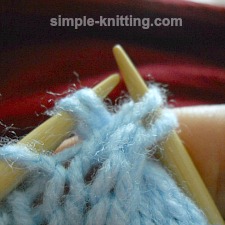
Step 6. Then slip the 2 stitches from the right needle over to the left needle. And now the second 2 sts are in front of the first 2 stitches and the stitches are crossed, (rearranged)
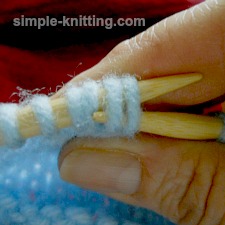
So all I did was move the 2nd set of stitches to the front of the line. The cable is basically made.
Step 7. Now all you do is knit those 4 stitches
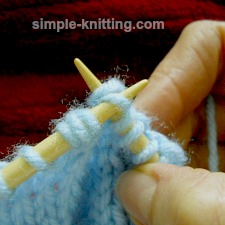
Step 8. And there you have your little cable
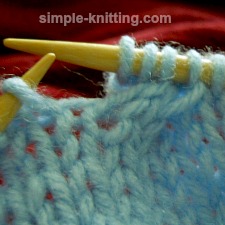
And that's how to knit cables without a cable needle. It's honestly not that difficult and I found it easier than fiddling with the cable needle.
So if the cable needle feels awkward or the stitches slip off this might be a nice alternative plus you may not have a cable stitch holder so this is great knitting technique to have.
What About Left Cross Cables Without a Cable Needle?
If you want to make a left cross cable you'll put your right needle into the second 2 stitches in the back of your knitting.
That's the only difference.
To knit a right cable the right needle goes into the front of the stitches.
To knit a left cable the right needle goes in the back of the stitches.
Everything else stays the same.
I hope you will try this cable knitting technique. You just may start to enjoy knitting cable stitches just like I did.
Still uncomfortable knitting cable stitches without a cable needle?
That's okay, it's not for everyone but it's really fun to try it.
You may enjoy knitting cables the regular way and I've made a detailed page about that too.
And I'm going to suggest a fabulous cable stitch holder to buy. This is the best kind and you won't need to worry about your stitches sliding off.
I am a participant in the Amazon Services LLC Associates Program, an affiliate advertising program designed to provide a means for sites to earn fees by advertising and linking to Amazon.com and affiliated sites. If you make a purchase through one of my links I may receive a small commission. This will not affect the purchase price and you will not pay more when you buy through my link.
This is the cable stitch holder I use. It comes in three sizes too which can be handy when you're working with different types of knitting yarn.
In fact it's my favorite when I don't use this method and I find it much more comfortable to use too.


Comments